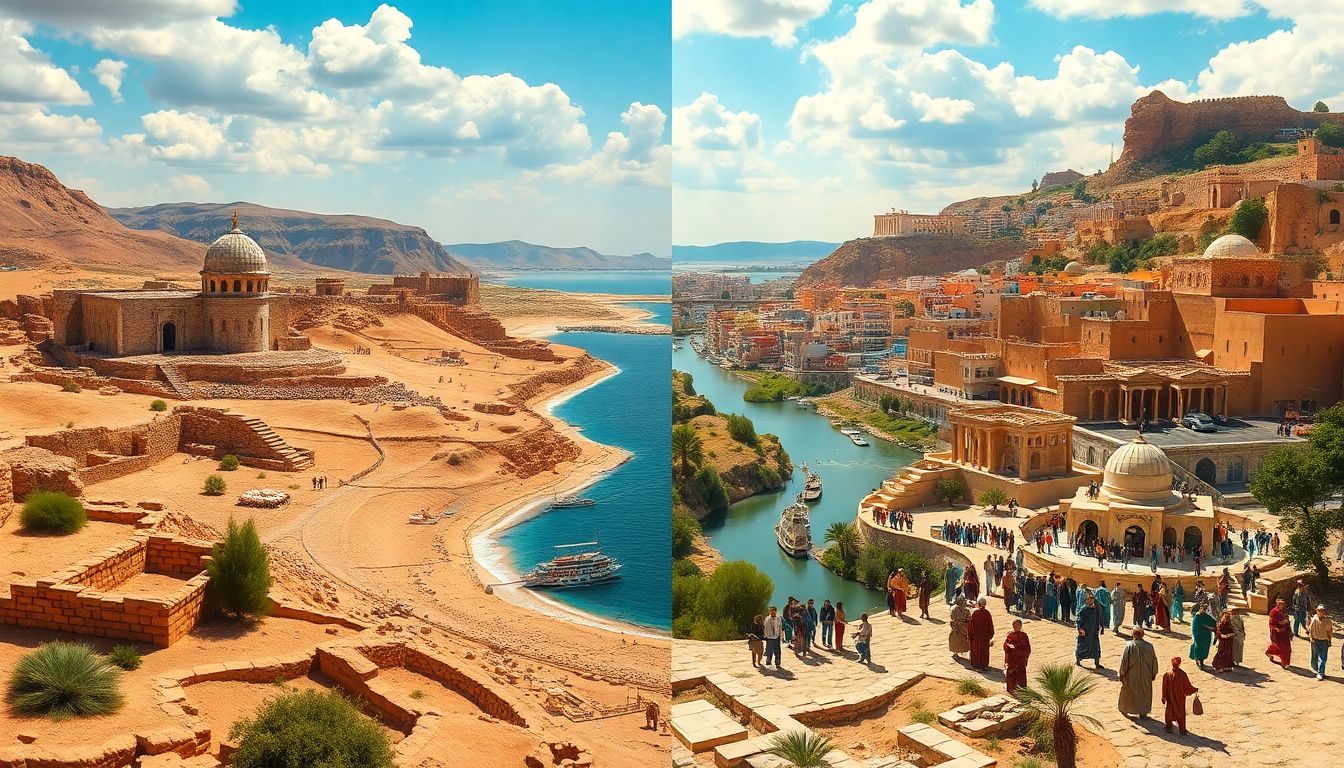10 Biblical Places Then and Now: Historical Significance and Modern-Day Relevance

10 Biblical Places Then and Now: Historical Significance and Modern-Day Relevance
Introduction
Traveling to biblical sites feels like stepping into history itself. These locations are more than just stories from ancient texts—they are places that shaped religion, culture, and history. Over thousands of years, these sites have changed, blending their spiritual roots with modern life. Understanding them helps us see their importance today and how they continue to inspire millions worldwide.
Historical and Biblical Significance of These Locations
The Role of Geography in Biblical Narratives
Geography has always played a key role in biblical stories. Mountains, rivers, and cities often become symbols or setting for major events. For instance, Mount Sinai is where Moses received the Ten Commandments. These places aren’t just backdrops—they influence the stories and lessons of faith.
Importance of Archaeology in Confirming Biblical Locations
Archaeology brings these ancient places to life. Finds like old cities, artifacts, and inscriptions support the biblical accounts. For example, excavations in Jericho reveal walls that might match the city’s famous fall. These discoveries help us trust the stories and learn more about the people who lived there.
Top 10 Biblical Places and Their Modern-Day Counterparts
Jericho: The Oldest Known City
- Historical context: Biblical account states Joshua and the Israelites destroyed Jericho's walls.
- Today: It’s a UNESCO World Heritage site with ongoing archaeological digs.
- Notable facts: People have lived there since around 9000 BCE, making it the oldest city we know.
Jerusalem: City of David and Holy Sanctuary
- Historical significance: Jerusalem is sacred to Jews, Christians, and Muslims.
- Modern relevance: It’s the capital of Israel and welcomes millions of tourists annually.
- Key sites: Western Wall, Dome of the Rock, and the Church of the Holy Sepulchre draw visitors from around the world.
Bethlehem: Birthplace of Jesus
- Biblical mentions: The Nativity stories in Luke and Matthew highlight Bethlehem.
- Current day: This city draws thousands of pilgrims and is a UNESCO World Heritage site.
- Tourist attractions: The Church of the Nativity stands as a symbol of Jesus’ birth.
Mount Sinai: The Giving of the Ten Commandments
- Biblical importance: Moses ascended here to receive God's laws.
- Contemporary setting: It’s a popular pilgrimage spot with Saint Catherine’s Monastery nearby.
- Activities: Many go hiking or participate in religious retreats on this mountain.
The Dead Sea: The Lowest Point on Earth
- Biblical references: Mentioned in Genesis and Ezekiel, often symbolizing despair or cleansing.
- Modern significance: It’s famous for therapeutic mud and mineral baths.
- Environmental notes: Its high salinity allows people to float easily, unique in the world.
Nazareth: The Childhood Home of Jesus
- Biblical references: Annunciation and early childhood stories took place here.
- Today: It’s a lively city with many churches and an active Christian community.
- Main site: The Basilica of the Annunciation attracts many visitors each year.
Dan: The Border of the Promised Land
- Biblical context: Located at the tribal boundary of Israel, hosting divine messages.
- Today: Archaeologists have uncovered ruins that shed light on biblical tribes.
- Significance: It provides a glimpse into ancient biblical civilization.
Sea of Galilee: Miracles and Ministry
- Biblical significance: Jesus performed many miracles here and preached.
- Modern attraction: People take boat rides and spiritual retreats on its waters.
- Environmental aspect: As a freshwater lake, it supports local ecosystems and communities.
Capernaum: Jesus’ Base of Operations
- Biblical importance: Known as Jesus’ home base and a healing site.
- Current status: Ruins include an ancient synagogue and house remains.
- Tourist insight: Many Christians visit to follow in Christ’s footsteps.
Mount Ararat: Legend of Noah’s Ark
- Biblical mention: It’s where the floodwaters settled after the great flood.
- Modern exploration: In Turkey, it’s the focus of many searches for Noah’s Ark.
- Controversies and discoveries: Despite many claims, no conclusive evidence exists yet.
How These Locations Influence Faith, Culture, and Tourism
Religious Impact
People go on pilgrimages for spiritual growth. Visiting these sites helps deepen faith and understanding. They often act as symbols of hope, renewal, and divine presence.
Cultural and Archaeological Contributions
These locations preserve stories from thousands of years ago. They teach us about ancient peoples, their customs, and their beliefs. They’re vital for understanding human history and religion.
Tourism and Economy
Religious tourism boosts local economies. Visitors help fund site preservation and community development. But increased tourism also brings challenges like environmental impact and site maintenance.
Practical Tips for Visiting Biblical Sites Today
- Plan visits for spring or fall to avoid extreme weather.
- Book guided tours to gain historical insights.
- Respect local customs, prayer spaces, and archaeological rules.
- Support local communities by buying locally-made crafts or donating.
Conclusion
From Jericho’s ancient walls to Jerusalem’s sacred streets, these biblical locations connect us with centuries of faith and history. They reveal stories of hope, struggle, and divine guidance that still resonate today. Visiting or learning about these sites offers a deeper appreciation of our shared spiritual heritage. Explore these places with respect, and they may inspire your own faith journey.
Key Takeaways
- Biblical sites hold deep historical, cultural, and spiritual value.
- Archaeology confirms many biblical stories.
- Responsible tourism helps preserve these landmarks for future generations.
- These locations continue to unite faith, history, and culture across the world.
















0 Comments